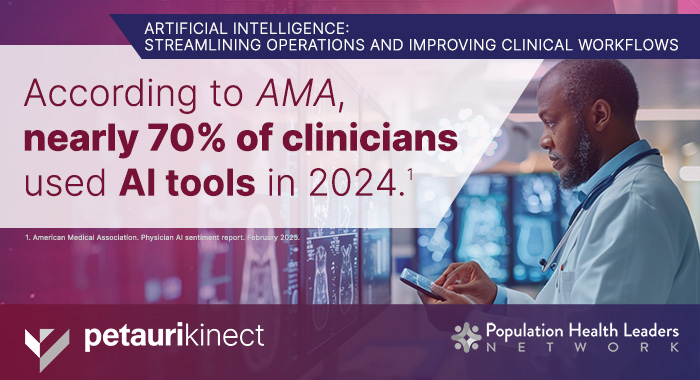Population Health Leaders Network Insights Into AI in Healthcare

Artificial Intelligence (AI) is no longer a futuristic concept. It is a present-day force reshaping healthcare delivery. Its potential is especially promising in rural and underserved communities, where access to care is often limited and providers are stretched thin. By simulating human intelligence—learning, reasoning and decision-making—AI can help close care gaps, improve outcomes and support overburdened clinicians.
Bridging Gaps and Building Smarter Systems
Not all AI is created equal. As healthcare organizations explore AI solutions, it is essential to consider the three categories of AI. Categories include:
- Assistive AI: Automates routine tasks like transcription, freeing up time for complex care
- Augmentative AI: Enhances clinical decision-making with insights beyond human reach
- Autonomous AI: Operates independently to generate clinical conclusions such as AI-powered diagnostic imaging
Improving Clinical Workflows
AI is already making a measurable impact on clinical workflows by supporting patient identification and diagnosis. Factors include:
- Clinical Documentation: AI-powered scribing tools summarize patient records and suggest treatment options
- Diagnostics: AI expands access to radiology, lab services, ophthalmology and dermatology, especially in rural settings
- Remote Patient Monitoring (RPM): AI-integrated devices enable the real-time tracking of vital signs—such as blood pressure and glucose—bringing care closer to home
- Symptom Checkers: AI tools help patients determine the appropriate level of care, reducing unnecessary travel and ER visits
Innovative platforms like Clinithink use natural language processing to detect early signs of conditions such as cognitive decline or undiagnosed lung cancer by scanning clinician notes and identifying pre-diagnostic patterns. Meanwhile, Cadence analyzes RPM and patient-reported outcomes to predict congestive heart failure, enabling earlier intervention and more effective treatment.
However, success depends on prompting. The effectiveness of large language models hinges on how well they are trained and retrained. Clear, specific prompts are essential—one omission can change the outcome entirely.
Streamlining Operations
Some health systems are starting with operational use cases before integrating AI into clinical workflows. This phased approach enables learning from past experiences and mitigates risks. Examples include:
- Prior Authorizations: AI is accelerating approvals while maintaining human oversight. However, over half of practices lack API interfaces between EHRs and health plans, and the cost of implementation remains a barrier
- Pharmacy Coordination: AI can streamline prescription workflows by scanning physician notes and routing them directly to pharmacies for verification, reducing delays and administrative burden
- Care Management: AI can also impact care management and transitions of care, where Agentic AI can guide patients to the right resources, even when they are unsure of what to ask
Implementation Considerations
Despite its promise, AI must be implemented thoughtfully. Considerations include:
- Data Bias: AI trained on non-representative populations can yield inaccurate or inequitable results, potentially exacerbating disparities further
- Cybersecurity: AI systems can be vulnerable to phishing and data breaches
- Provider De-Skilling: Over-reliance on AI may erode clinical judgment
- Digital Divide: Not all patients have access to the technology needed to benefit from AI tools
Public education is crucial for clarifying AI’s role in healthcare and dispelling misconceptions, particularly those surrounding the use of automation in decision-making. Organizations must also validate AI tools to ensure they don’t reinforce disparities.
There is growing interest in the real-world applications of AI in healthcare. Emerging focus areas include team-based care models, Agentic AI for patient navigation and expanded use in early detection and monitoring. As we face a shortage of healthcare resources, how we incorporate AI into care delivery will shape the future of health systems. The reality is AI is here. We can either embrace it or watch the train leave the station.
Reach out to Petauri Kinect to discuss how your organization can better understand the evolving needs for AI in the healthcare landscape or collaborate with healthcare stakeholders.
At Petauri Kinect, we understand that life sciences and health systems are critical in addressing quality gaps and fostering partnerships to achieve sustainable, equitable and cost-effective healthcare solutions.
If your organization wants more information about how the evolving regulatory landscape impacts healthcare or how to collaborate with key stakeholders, please contact us here. We look forward to discussing new engagement approaches and transformative solutions with you!

Share